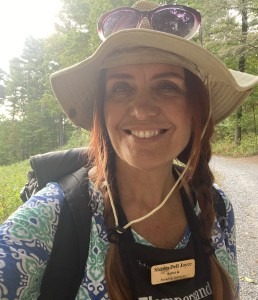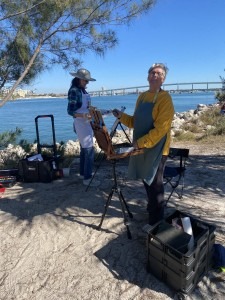
When we think of art, we often think of the end product; the painting hanging on the wall, the performance, the piece of music. Art is also the production-the process-the journey. It’s a community-building activity. Art is a way to connect with other cultural creatives to produce, and inspire each other to be our best, and achieve artistic excellence.
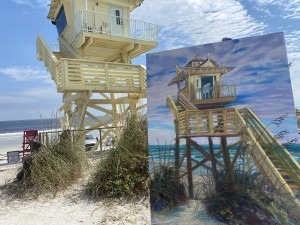
Plein air is French for (outdoors) or painting outside in the fresh air with bugs, transient light, curious tourists and birds and all the other glorious distractions that entails. Most people paint individually in their studios, but plein air allows you to paint with a group and have the safety of others nearby, as well as the c camaraderie.
What I love about my plein air class is the 25 people can be painting in the same area, looking at the same things, and no two paintings are alike. Each one of us interprets what we see through our own lens. That lens is our life experience, our special way of seeing the world. It’s beautiful and uniquely you. Not a photo, or 100% accurate, but rather your impression of what you are seeing.

We influence each other. When you are painting with a group, you get to see how someone else interprets the same pattern of light and dark you see, and sometimes you learn from you peers and how they approach the subject. I often learn as much from others as from teachers (including me). You also get to know each other and what artistic goals and can encourage each other when breakthroughs happen.
Plein air is not easy. Many artists think they should be able to paint as well en plein air as they do in the studio and are surprised to find themselves standing in front of a beautiful scene without the slightest clue of what to do next.
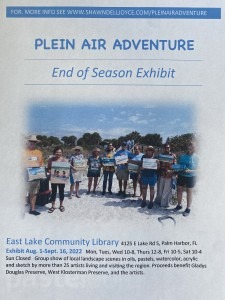
That’s why its better to take a class first then join a plein air group. In a class, you will learn how to “crop” the real world into a manageable painting, instead of painting everything you see. You learn to start with a value sketch, which then shows you where your focal point will be, and helps you plan your painting. Almost all media works from dark to light, so a value sketch shows you where to start-with your strong pattern of darks, then methodically work your way through the values up to the highlights which go last. A value sketch plots out these values and the order they will be painted. Watercolor is the exception as you work from light to dark usually.
Once you have avalue sketch you have a plan and your composition. Now you just have to paint it.
This can be tricky with light changing constantly, bugs landing on you, and tourists peeking over your shoulder and talking to you. Try to keep on track, starting with the darks, then moving methodically through values to lights. Keep to the plan, even if an egret lands in the center of your composition, try not to deviate now, stick to the plan. Sunlight changes drastically in two hours. If you keep changing your shadows and lights, you could spend the whole day chasing the light in your painting. Try to stick to your initial plan and sketch. Follow your heart and your internal guidance here. Don’t be distracted and lose focus.

Once you are finished with a painting, leave it alone.
The worst thing you can do to a painting is overwork it.
It’s also the easiest thing to do. We often think; “just one more mark and it will look just right” and then that one more mark obscures what we really liked about the painting to begin with. We spend hours painting, wiping, and repainting the same thing. It never works. Instead, walk away. This takes spiritual fortitude. Its much harder to walk away from a fresh painting and not overwork it, than it is to kill it. Having friends nearby who remind you not to overwork is always helpful!
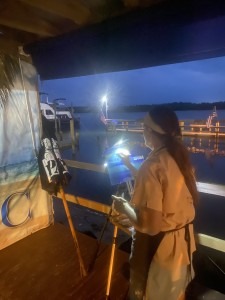
Most plein air works can be done in 2-3 hours tops. The more you paint, the quicker you get, also the more accurately you paint.
It doesn’t happen overnight and may not happen the first few times you paint. But usually about the 4th class people start to finish a painting in one class, and around the 6th class they start to paint what they see and like it. There’s no rule here, it really depends on your level of expertise with your media. No beginner is going to paint better in plein air than they are already. It’s another layer of challenge to work outside.
If you are good at copying photos and it is no longer a challenge to you, then you are ready for plein air.
Its always more interesting to see how you interpret a scene than a photo of the same scene. People LOVE to see the “hand of the artist.” Think about your favorite paintings. Monet’s waterlilies would be far less compelling if it were a photograph. Don’t get me wrong, photos are art, but that’s not what you are here for. You’re a painter.
Plein air sharpens your perceptual ability. It also sharpens your focus and ability to concentrate on your painting. You know the light is changing so you paint faster. If you compete professionally, you will have two hours to complete and frame a painting to turn in. This positive pressure gently nudges you to paint more accurately and quicker.
If you paint with my group, you have the added benefit of seeing some Old Florida sites right here in Pinellas County that may not be here much longer. We see mangrove forests and wild marshes, learn about storm water mitigations, wildlife migration and the importance of pocket-parks to neighborhood wildlife. You cannot help but love the landscape you paint.
There are other groups in the area; Shadow Chasers paint North of us in Pasco, Light Chasers paint South of us in Manatee County, Plein Air Colony paints in South St. Pete, and the Plein Air Irregulars paint in Northern Pinellas. My group is an organized class that starts with a demo that is not specific to any medium, like painting clouds, and creating the illusion of perspective. People paint from 9am-11:45 with assistance as needed and one-on-one feedback. We meet for group critique at 11:45-12:15 or so.
If your goal is to paint what you see, plein air is for you!
